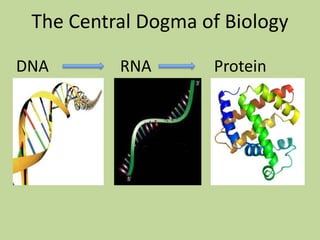
The central dogma
- 1. The Central Dogma of Biology DNA RNA Protein
- 2. The Central Dogma of Biology Protein synthesis begins with a section of DNA called a gene which contains the information for the production of a single protein.
- 3. The Central Dogma of Biology DNA RNA Protein Transcription Translation
- 5. There are three important differences between the structure of DNA and the structure of RNA. 1. The pentose sugar found in RNA is ribose instead of deoxyribose. 2. The nucleotide thymine found in DNA is replaced with uracil in RNA. 3. DNA is a double-helix, and RNA is a single strand.
- 6. Transcription RNA Polymerase breaks the hydrogen bonds between the two strands of DNA.
- 7. Transcription One of the DNA strands serves as a template for the construction of a new messenger RNA.
- 8. Transcription Complementary nucleotides align themselves along the exposed nitrogen bases of the DNA.
- 9. Transcription The newly constructed mRNA molecule is released into the nucleus and the DNA reforms. mRNA DNA RNA Polymerase
- 10. Transcription The transcription phase of protein synthesis is over when mRNA exits the nucleus through a nuclear pore and enters the cytoplasm. http://www.youtube.com/watch?v=41_Ne5mS2ls
- 11. Protein Synthesis: Part Two Translation Translation takes place in the cellular cytoplasm. The process is mediated by large molecular machines called Ribosomes.
- 12. Vocabulary: Ribosomes: the molecular structure responsible for translating mRNA into protein.
- 13. Translation Most ribosomes are found on the outside membrane of the rough endoplasmic reticulum.
- 14. Rough Endoplasmic Reticulum: A membranous structure in the cytoplasm of a cell where proteins destined for export are assembled. Vocabulary:
- 15. Translation starts when a ribosome attaches to a messenger RNA molecule and begins to assemble amino acids based on the sequence of codons in the mRNA molecule. Translation
- 16. DNA and RNA use only four bases to create a code that determines the sequence of 20 different amino acids in the final protein. In order to do this nucleic acids use three letter “words” called codons to indicate each of the amino acids in the sequence. What are codons?
- 17. Codons
- 18. The Genetic Code
- 19. A third form of RNA called transfer RNA, tRNA, is found in the cytoplasm. Translation
- 20. Translation The tRNA molecule has a sequence of three nucleotides called an “anticodon” at one end and a corresponding amino acid at its opposite end. Anticodon Amino Acid Transfer RNA
- 21. Translation During translation the anticodon on the tRNA aligns with the codon on the mRNA
- 22. The ribosome provides a site where tRNA molecules align with the codons on the mRNA molecule. Translation
- 23. Translation The amino acid on the tRNA is then “transferred” to the growing protein chain and the tRNA is released back into the cytoplasm to pick up another amino acid. http://highered.mcgraw- hill.com/olcweb/cgi/pluginpop.cgi?it=swf::535::535::/sites/dl/free/0072437316/120077/ micro06.swf::Protein%20Synthesis
- 24. Eventually the ribosome reaches the end of the mRNA and protein sequence is complete. Translation http://www.youtube.com/watch?v=41_Ne5mS2ls http://www.youtube.com/watch?v=Jml8CFBWcDs&feature=related
- 26. “This is too hard.”
- 27. What happens when DNA makes a typo?
- 29. Myostatin is a protein which inhibits the growth of muscle tissue. Defect in myostatin gene results in extraordinary muscle growth
- 30. Albinism is a genetic defect of an enzyme involved in the production of melanin.